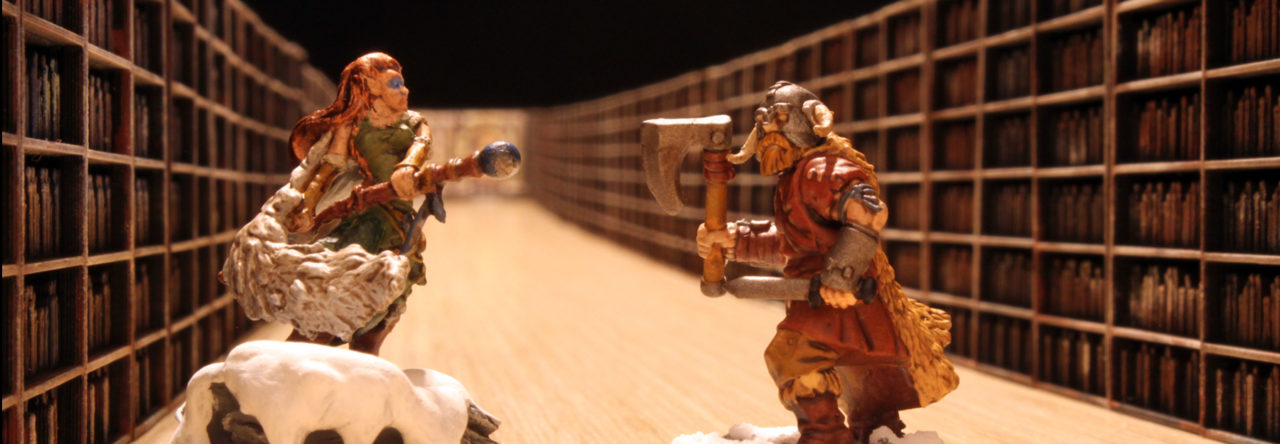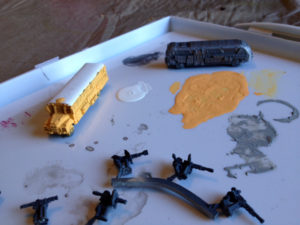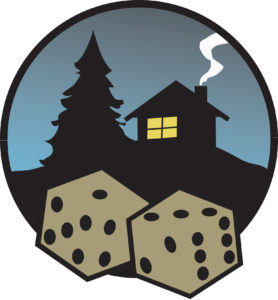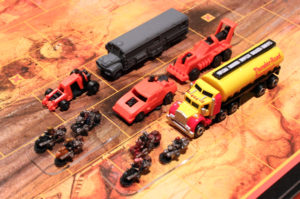That’s no Moon, it’s Space St- err, custom carrying case!
Tag: miniatures game
So I finally have an open weekend to catch up a little bit and it’s time to recap the events of this year’s Cabin Con gathering. We decided to extend the convention by starting on Wednesday night instead of Thursday night. This is the length of our annual Gen Con adventure and that length always felt like the perfect amount of time without becoming too long.
I picked up an out of town friend on Wednesday afternoon and after a bit of traffic, we met up with some of the others and caravaned up to the cabin. After some grocery shopping to stock up, we made it to the cabin and immediately busted out the games.
In less than two weeks, my friends and I will trek into the mountains and unofficially start off the summer game convention season with our own private little game convention, CabinCon.
After working up a lot of pimped-out items for my copy of Thunder Road, I’m still finding I want to do more. I want to add some different features and I started thinking of possibly moving it to a new setting and an urban Death Race theme seemed appropriate and interesting.
When I first picked up Thunder Road, I noticed the UK version (the one I own) is actually a great match for the 10mm Dropzone Commander‘s scale models.
One of the main reasons I wanted to start this blog was to show off my pimped games and talk about how I created them. After a while, I started thinking about why we pimp out our games and I found the question compelling enough that I’m starting a new blog series called, simply, “Why We Pimp.” In this series, I’ll focus on a narrow aspect of board game pimping and look at it from the philosophical perspective.
Of course, the biggest question is the general “why?” Why do it at all? Board game publishers spend countless hours designing beautiful games and yet we still want more. Manufacturing for board and table top games has never been higher and the trend now is actually over-producing the value in a game. Take Cool Mini or Not‘s (CMoN) fantasy sports game, Kaosball by Eric Lang. This is a relatively simple sports game with minis on a game board but CMoN decided really ramp up the production value by creating countless teams, each with their own minis and game bits.
I really love miniature games. I love the spectacle, the freedom of gaming choices, the complex strategies, and the unique customizations you can achieve to bring individuality to your game components. Pimping minis games is so ubiquitous though that I’ve seen it argued that the vast majority of effort in a minis game isn’t pimping at all. Rather, it is more like a minimum requirement to play the game, much like punching out game tokens are in a board game. I can see both sides of the argument but I grew up and still consider myself a board gamer first, minis gamer second so anything beyond punching tokens or bagging up components feels like work and if it is work making the game look better or play better, I consider it pimping.
This “work” aspect is my least favorite part of minis games. I want to play the game so I can figure out what, or even if I’d like to emphasize something when I decide to pimp it out. I’m not a fan of some of the staple hobby aspects such as modelling and painting. The other issue I have with the genre is storage. Even if I had the room, storing all the extras that come along with miniature games like terrain, custom boards, modeling and painting tools, and the miniatures themselves can eat up way too much storage real estate.
One thing that has fascinated me in board games is the concept of taking a standard game and blowing the whole thing out to a larger size. These “super-sized” or “Giant/Mega” versions of games are usually seen at game conventions or public spaces. I suspect this is mostly due to the cost involved in creating giant versions of the game and the space needed to play/store it but it also creates a spectacle and attracts a lot of attention.
It’s the spectacle that drives us to make giant versions of these games. It’s this unique aspect of play that engages the players and the audience in a way that takes something very familiar and maybe even boring and makes it into a memorable experience. For me, playing a giant version of the game brings me back to a child-like state where the pieces barely fit in my hands. My movements are awkward and clumsy and I become fully immersed in the game itself. It occupies a wide field of my vision and I am in the game as completely as I can ever be.
No, I’m not talking about that lame James Cameron movie, I’m talking about the tree that houses your nest base in Plaid Hat Games’ new Tail Feathers game.
The game has anthropomorphic mice who battle evil rats and bugs while riding friendly birds through the forest. It’s a pretty fun game that blends tabletop minis with standard board game elements to create a dynamic and immersive environment.
Being a minis player, I like to pimp out my terrain but always want my battlefield to be functional over just looking good. After playing a game, I started eyeing that “tree” template and wondered if we could take the game a little further.

Great looking game, albeit a little…. flat. image from Plaid Hat Games website.




